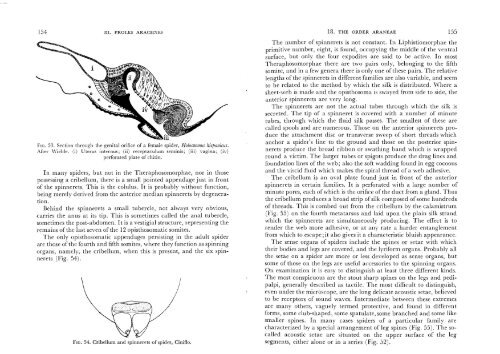You also want an ePaper? Increase the reach of your titles
YUMPU automatically turns print PDFs into web optimized ePapers that Google loves.
154 Ill. PROLES ARACHNES<br />
FIG. 53. Section through the genital orifice of a female spider, Holocnemus hispanicus.<br />
After Wiehle. (i) Uterus internus; (ii) receptaculum seminis; (iii) vagina; (iv)<br />
perforated plate of chitin.<br />
In many spiders, but not in the Theraphosomorphae, nor in those<br />
possessing a cribellum, there is a small pointed appendage just in front<br />
of the spinnerets. This is the colulus. It is probably without function,<br />
being merely derived from the anterior median spinnerets by degeneration.<br />
Behind the spinnerets a small tubercle, not always very obvious,<br />
carries the anus at its tip. This is sometimes called the anal tubercle,<br />
sometimes the post-abdomen. It is a vestigial structure, representing the<br />
remains of the last seven of the 12 opisthosomatic so mites.<br />
The only opisthosomatic appendages persisting in the adult spider<br />
are those of the fourth and fifth somites, where they function as spinning<br />
organs, namely, the cribellum, when this is present, and the six spinnerets<br />
(Fig. 54).<br />
FIG. 54. Cribellum and spinnerets of spider, Ciniflo.<br />
18. THE ORDER ARANEAE 155<br />
The number of spinnerets is not constant. In Liphistiomorphae the<br />
primitive number, eight, is found, occupying the middle of the ventral<br />
surface, but only the four expodites are said to be active. In most<br />
Theraphosomorphae there are two pairs only, belonging to the fifth<br />
somite, and in a few genera there is only one of these pairs. The relative<br />
lengths of the spinnerets in different families are also variable, and seem<br />
to be related to the method by which the silk is distributed. Where a<br />
sheet-web is made and the opisthosoma is swayed from side to side, the<br />
anterior spinnerets are very long.<br />
The spinnerets are not the actual tubes through which the silk is<br />
secreted. The tip of a spinneret is covered with a number of minute<br />
tubes, through which the fluid silk passes. The smallest of these are<br />
called spools and are numerous. Those on the anterior spinnerets produce<br />
the attachment disc or transverse sweep of short threads which<br />
anchor a spider's line to the ground and those on the posterior spinnerets<br />
produce the broad ribbon or swathing band which is wrapped<br />
round a victim. The larger tubes or spigots produce the drag lines and<br />
foundation lines of the web; also the soft wadding found in egg cocoons<br />
and the viscid fluid which makes the spiral thread of a web adhesive.<br />
The cribellum is an oval plate found just in front of the anterior<br />
spinnerets in certain families. It is perforated with a large number of<br />
minute pores, each of which is the orifice of the duct from a gland. Thus<br />
the cribellum produces a broad strip of silk composed of some hundreds<br />
of threads. This is combed out from the cribellum by the calamistrum<br />
(Fig. 55) on the fourth metatarsus and laid upon the plain silk strand<br />
which the spinnerets are simultaneously producing. The effect is to<br />
render the web more adhesive, or at any rate a harder entanglement<br />
from which to escape;it also gives it a characteristic bluish appearance.<br />
The sense organs of spiders include the spines or setae with which<br />
their bodies and legs are covered, and the lyriform organs. Probably all<br />
the setae on a spider are more or less developed as sense organs, but<br />
some of those on the legs are useful accessories to the spinning organs.<br />
On examination it is easy to distinguish at least three different kinds.<br />
The most conspicuous are the stout sharp spines on the legs and pedipalpi,<br />
generally described as tactile. The most difficult to distinguish,<br />
even under the microscope, are the long delicate acoustic setae, believed<br />
to be receptors of sound waves. Intermediate between these extremes<br />
are many others, vaguely termed protective, and found in different<br />
forms, some club-shaped, some spatulate, some branched and some like<br />
smaller spines. In many cases spiders of a particular family are<br />
characterized by a special arrangement of leg spines (Fig. 55). The socalled<br />
acoustic setae are situated on the upper surface of the leg<br />
segments, either alone or in a series (Fig. 52).















